The legal currency in Romania is the leu (“lei” in the plural) and its ISO 4217 code is RON.
Since it was founded in 1880, the National Bank of Romania (Banca Naţională a României -BNR) has been in charge of issuing lei banknotes and RON coins. One RON is divided into 100 bani (singular “ban”).
As of July 2023, the exchange rate of the Romanian leu against the euro is:
- 1 euro = RON 4.93
- 1 leu = 0.20 euros.
History of the Romanian leu
In the Romanian states of the 17th century, the Dutch thaler or thaler coin was used as currency. This one had the figure of a lion engraved on it. For this reason, the Romanians used to call them “lei”, which means lions in this language.
The custom of calling the coin “lion” remained even after the use of the coinage of the Netherlands was abandoned on Romanian territory.
In 2005 there was a great change in the country with what is called the redenomination of the national currency. This macro economic operation consisted of reducing the nominal value of the ROL currency denominations, cutting 4 zeros. Thus, 10,000 old lei became 1 new leu as of July 1, 2005, and the international code for the leu changed from ROL to RON.
Since then, the new leu (RON) has replaced the old leu (ROL) with a ratio of one new leu to 10,000 old lei. For a year the new money coexisted with the old (until December 31, 2016), and since January 1, 2007, RON has been used in Romania.
Romanian leu coins
The current Romanian coins (they were minted in 2005 and all have their value on the reverse and the Coat of Arms and the year of minting on the obverse.
- 1 ban coin: 2.4 grams, brass-plated steel and smooth edge.
- 5 bani coin: 2.8 g, copper-plated steel and fluted edge.
- 10 bani coin: 2.8 g, nickel-plated steel, fluted and smooth edge.
- 50 bani coin: 6.1 g and a mixture of copper, zinc and nickel.
On the BNR website we can see a complete section dedicated to Romanian leu coins and banknotes.
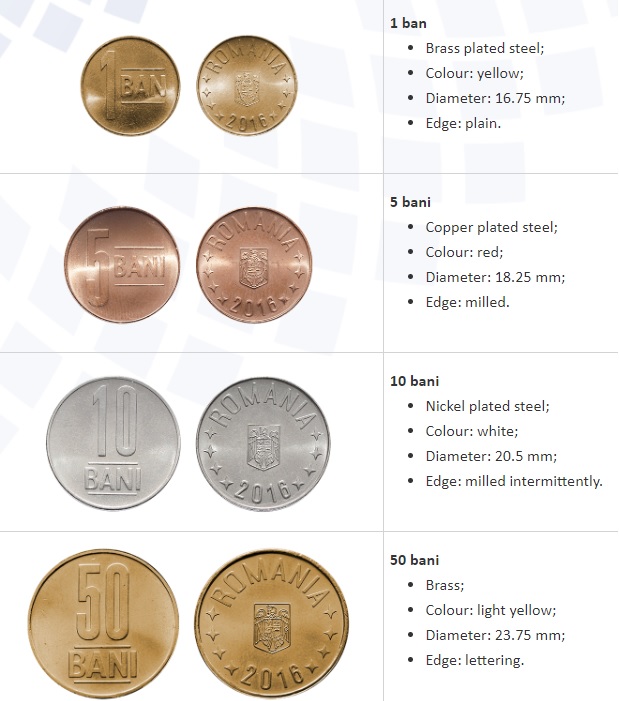
The National Bank of Romania is the only institution with the power to issue legal tender in the form of banknotes and coins to be used as a means of payment on the territory of Romania.
Banknotes and coins are accepted at their nominal value for the payment of public and private financial obligations. The BNR prepares the currency issuance program (coins and banknotes) in order to guarantee the liquidity requirements of the country and is the only one that can establish the nominal value, size, weight, design and any other technical characteristics of the banknotes and Romanian coins.
Romanian leu banknotes
The circulating series of RON banknotes were issued between 2005 and 2008.
Currently there are banknotes of the following denominations in circulation:
- 1 lei
- 5 lei
- 10 lei (2005 and 2008 editions)
- 20 lei
- 50 lei
- 100 lei
- 200 lei and
- 500 lei
All banknotes in the country have been made of polymer since 1999, which ensures a longer useful life with greater security controls.
As a curiosity, it must be said that the size of the new leu banknotes is the same as that of the euro banknotes.
1 leu banknote
Green in color and measuring 120×62 mm, it shows the writer Nicolae Iorga (1871-1940) on the obverse and the Cathedral of the Monastery of Curtea de Argés (Walachia region) on the reverse.
Iorga was a Romanian historian, university professor, literary critic, playwright, poet and politician. He was a member of parliament, president of the National Assembly after World War I, minister, and, between 1931 and 1932, prime minister of Romania.
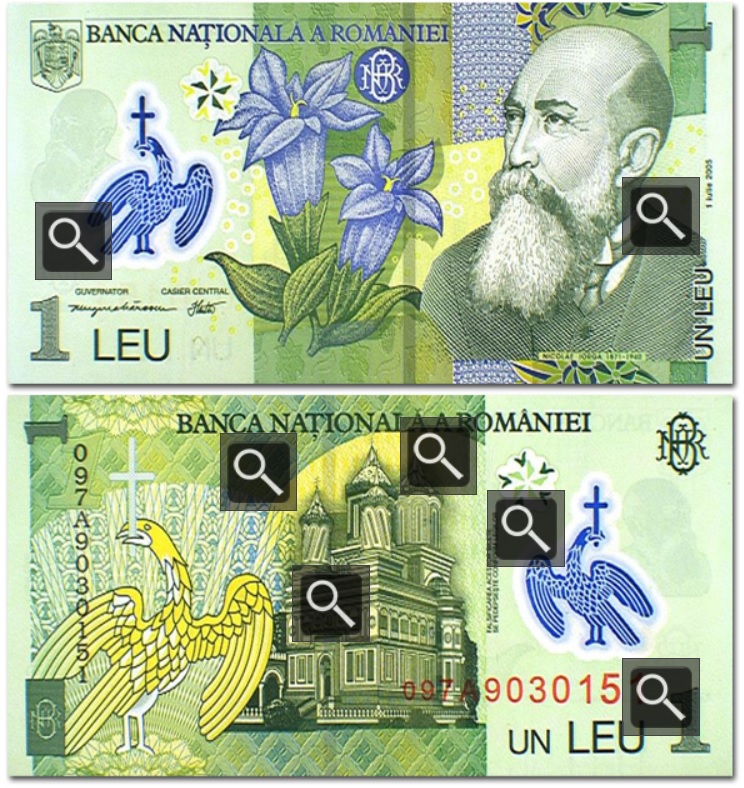
For this banknote they would give you at the date of this update in France, about 20 euro cents.
5 lei banknote
Violet and measuring 127 x 67 mm, the Romanian 5 lei note shows the coat of arms and the composer George Enescu (1881-1955). Enescu was a Romanian composer, violinist, pedagogue, pianist and conductor on the obverse and the Bucharest Athenaeum on the reverse.
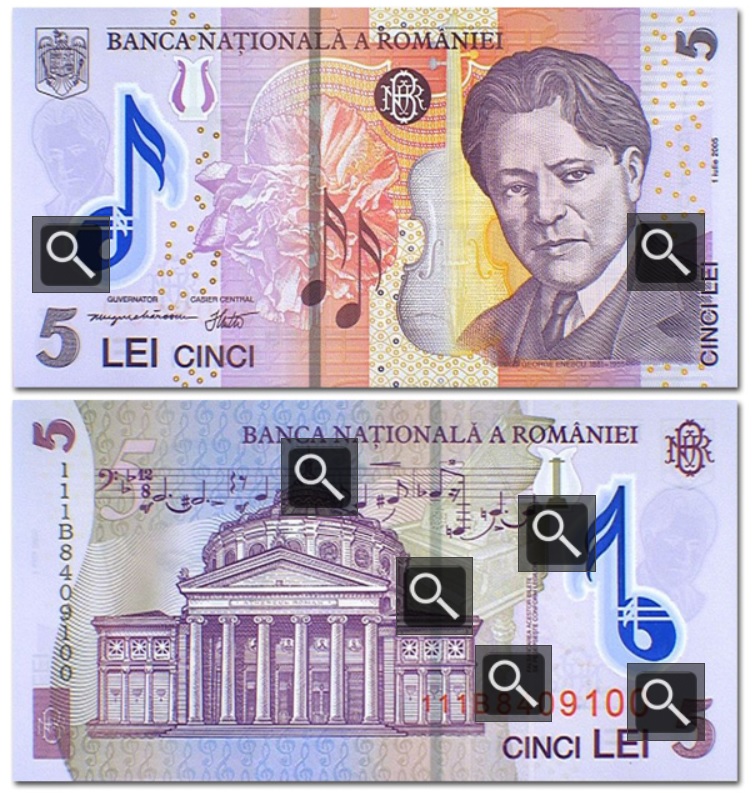
For this banknote they would give you about 90 euro cents on the date of this update in France.
10 lei banknote
The 10 Romanian lei banknote is pink and orange in color and measures 133 x 72 mm.
It has a portrait of the painter Nicolae Grigorescu (1838-1907), a post-impressionist Romanian painter of the 19th century, on the obverse and a house from the Oltenia region and the Rodica painting on the reverse.
Two versions of this banknote have been made and are in circulation, in 2005 and 2008 respectively.
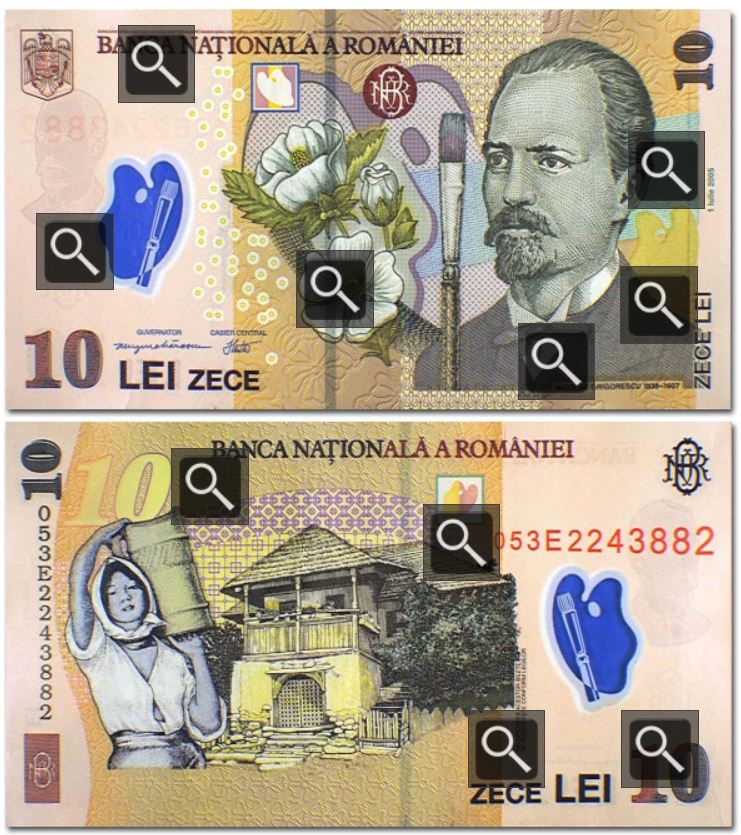
For this banknote, as of the date of this update in France, they would give you one euro and eightythree cents (€1.83).
20 lei banknote
The 20 Romanian lei banknote is olive green in color, measures 136 x 77 mm and is the newest of all the denominations in force in Romania (dating December 1, 2021).
Furthermore, for the first time, the Bank of Romania displays the portrait of a woman on its obverse. This is Ecaterina Teodoriu (1894-1917) Romanian heroine of the First World War. Teodoriu was initially a nurse and later joined the infantry of which she was an officer, to perish at the front in 1917.
The reverse of the 20 lei note shows the Mărășești Mausoleum (Mărășești Mausoleum) dedicated to fallen Romanian soldiers during World War I.
The mausoleum commemorates the Battle of Mărășești in which thousands of Romanian soldiers fell (it contains remains of 5,073 soldiers and officers).
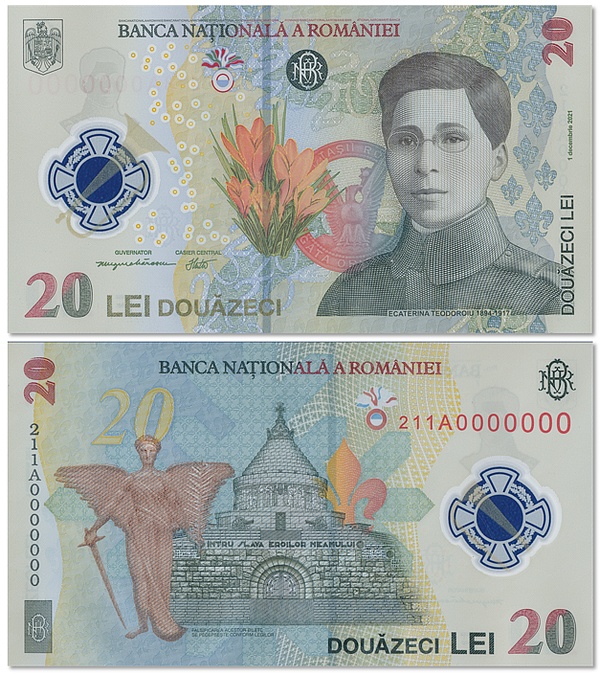
For this banknote they would give you €3.64 to change on the date of this update in France.
50 lei banknote
Yellow in color, this banknote measures 140 x 77 mm.
It shows the pilot and engineer Aurel Vlaicu (1881-1913), an edelweiss flower and a propeller on the obverse and an eagle head and a Vlaicu II airplane on the reverse. Vlaicu was a Romanian engineer, inventor, aircraft builder and pilot. He is considered one of the pioneers of world aviation.
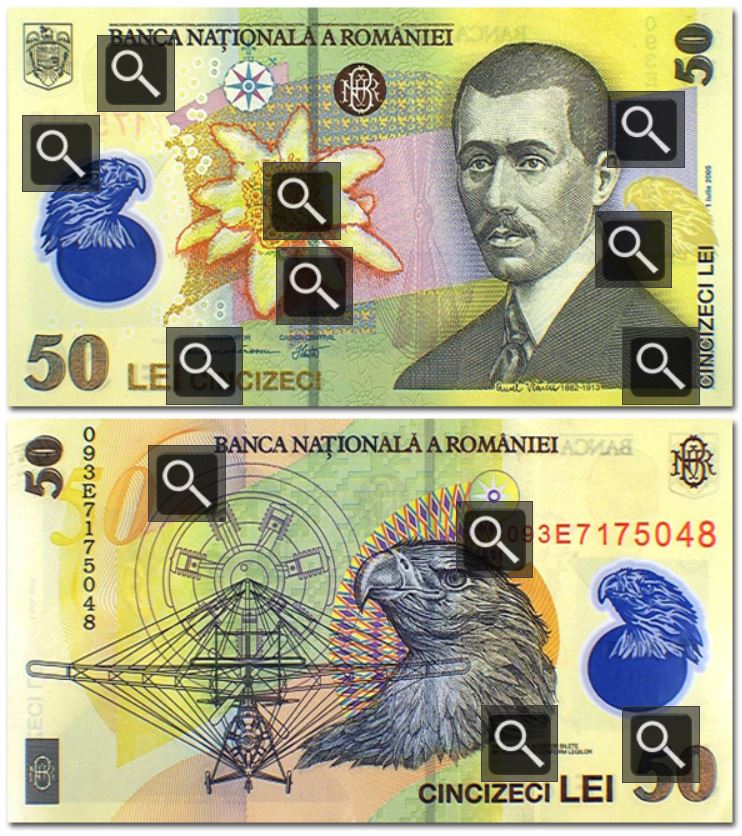
For this banknote they would give you €9.11 to change on the date of this update in France.
100 lei banknote
This banknote is blue in color, measures 147 x 82 mm and has the playwright Luca Caragiale (1852-1912) and a comedy mask on the obverse. The reverse is dedicated to the National Theater of Bucharest (I.L. Caragiale) and a tragedy mask.
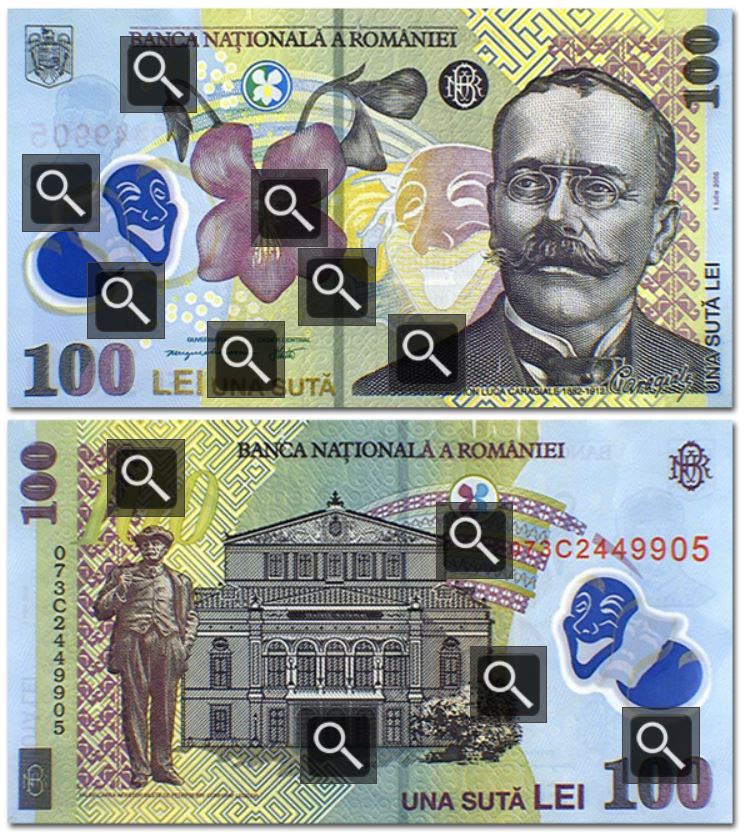
For this banknote they would give you €18.29 to change on the date of this update in France.
200 lei banknote
The 200 lei banknote is yellow, measures 150 x 82 mm and is dedicated to the writer Lucian Blaga (1895-1961) considered one of the great Romanian poets of the 20th century.
The obverse shows a portrait of the Romanian poet, playwright and philosopher and one of his poems. The reverse has a water mill and the Hamangia Thinker (Ganditorul de la Hamangia), a thousand-year-old sculpture of the Hamangia culture originating from Romania and Bulgaria.
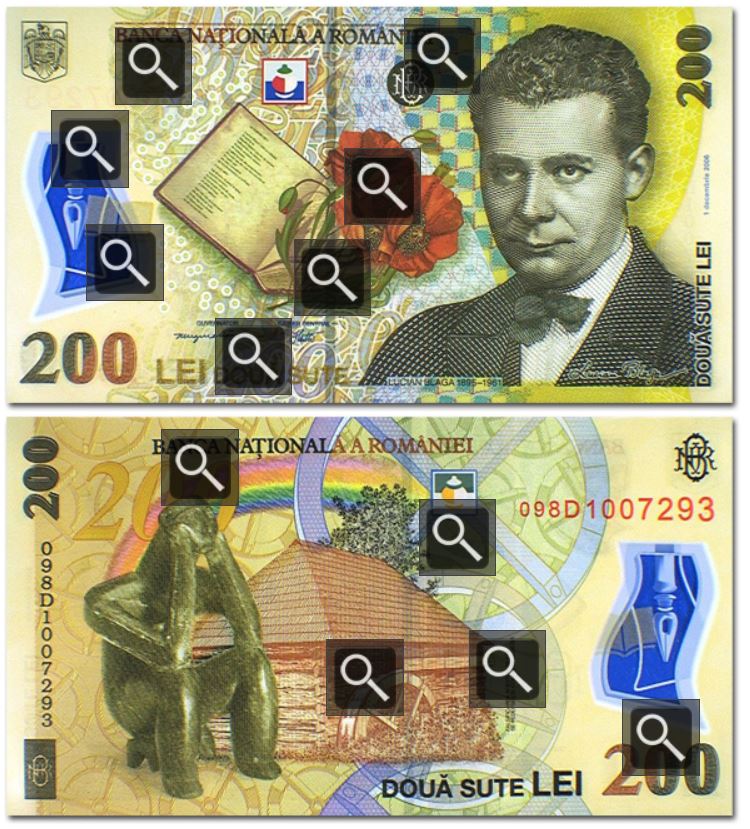
For this banknote they would give you €36.44 to change on the date of this update in France.
500 lei banknote
Green and blue, measures 153 x 82 mm. The obverse shows the best-known Romanian poet, novelist and journalist, Mihai Eminescu (1850-1889). The reverse shows the Iasi University Library inaugurated on November 23, 1841 and named after the poet (Mihai Eminescu University Library of the city of Iasi).
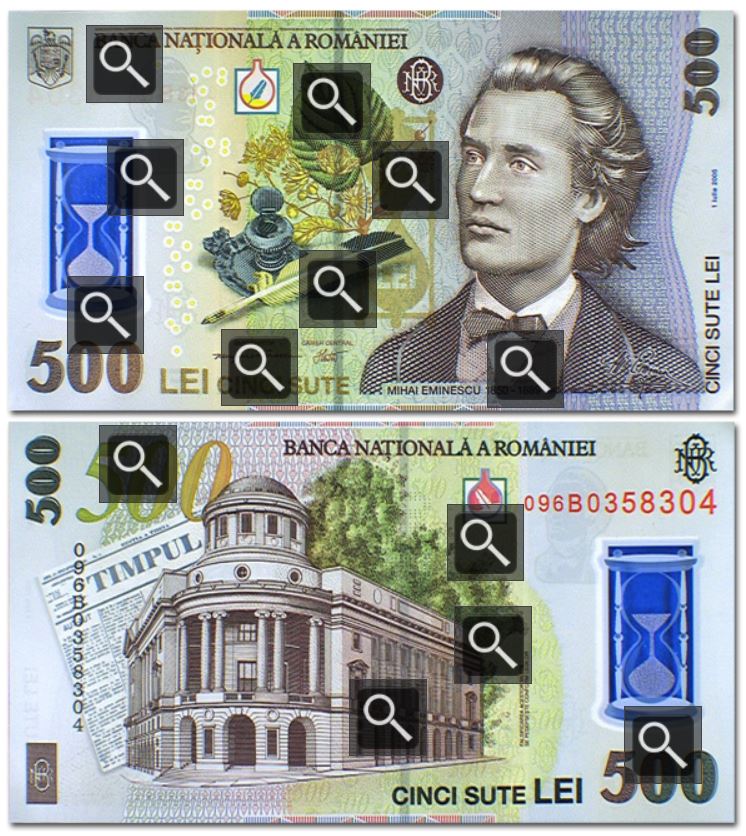
For this banknote they would give you, on the date of this update in France, 91.60 euros to change.
Euro to romanian leu exchange rate
If you search Google for “euro leu exchange” you will find dozens of websites (“currency converters”) that offer a “price” of the day. You will also see this graph with the prices of that pair of currencies from Google Finance. Something like this (July 26, 2023):
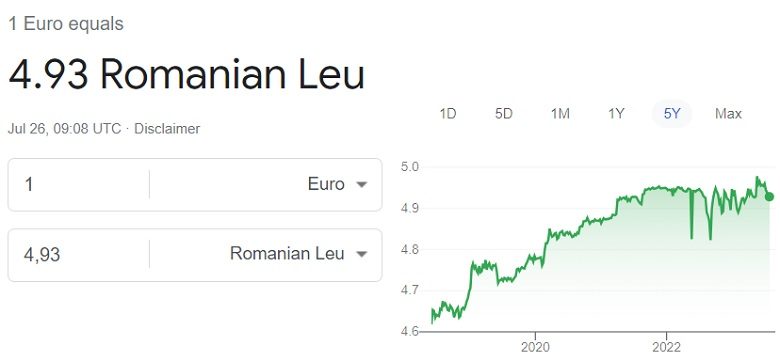
The euro to leu exchange rate for the last 5 years has remained above 4.6 lei with constant growth (strong euro compared to the Leu) up to the current 4.93 lei for each euro. The last three years the change remains quite stable above 4.90 lei per euro.
In any case, when you see these values in Google and other currency converters with your mobile, you should keep the following in mind:
-It is an unofficial price, and therefore unreliable. In other words, if you click on the “Disclaimer” link, you get this warning from Google Finance: “Google cannot guarantee the accuracy of the exchange rates displayed. Please confirm current rates before making a transaction that may be affected by changes in exchange rates.”
-These rates that you see are usually wholesale prices of the leu against the euro currency (currency and paper money currency are not the same).
-This rate can only be held by banks among themselves, that is, it is impossible to obtain it as an individual.
If you need lei in notes, you will have to go through the banknote retail market (bank or currency supplier). This means that the RONs have had to be “transported” by someone for you to enjoy them (or purchased from travelers from Romania passing through France previously).
Moving banknotes from one place to another has logistical costs that will make their sale price more expensive (the exchange rate that will be applied by whoever sells them to you). And the risk of depreciation also makes the holder of the banknotes more expensive to exchange for euros.
The Romanian leu is a currency that is not very abundant in France. As a result of this, its price is more expensive in France than in Romania. If you decide to buy lei in France, it is good to anticipate the purchase and reserve them online to obtain a better price and make sure that you will find them.
Where to exchange Romanian leu for euros in France
In France, the leu can be exchanged at banks, currency suppliers and airports. This is what you need to know about the three options before buying or selling your RON:
The airport is by far the worst option because of the high price at which leu are bought and sold. The currency suppliers that operate at the airport do not charge you a commission (Global Exchange), but they are more than charged with the high exchange margins that they apply to you. The profits from this lucrative business are shared between the manager and the currency supplier that operates at the airport.
For their part, banks have the ugly habit of charging commissions for practically everything, as you well know. In the currency exchange, in addition to applying a margin on the purchase or sale of lei, they apply a commission of between 1 and 3% on the volume exchanged, with a minimum of between 6 and 10 euros.
This means that currency exchange is not usually interesting at your bank, although that is what Comparer Devise is for, to show you the price at which foreign currency is sold and bought daily in currency suppliers, banks and the airport.
Finally, currency suppliers that do not operate at the airport do not usually charge you a commission if you contract your leu online (home delivery or online reservation with collection at one of their offices in the city center).
We recommend you see the prices of the currency suppliers that collaborate with Comparer Devise since they are quite competitive, and they vary every day.
Euro to romanian leu exchange rate today
To find out the Euro to Romanian leu exchange rate today, the best thing you can do is use our currency comparator.
- Euro to leu currency exchange (EUR-RON)
- Leu to euro currency exchange (RON-EUR)

Sin comentarios